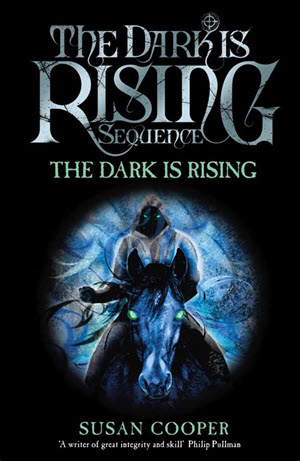The Dark is Rising
 As I expected, the long gap between Over Sea, Under Stone and The Dark is Rising saw a significant improvement in quality. Gone is the sub-Enid Blyton jolly tale of children on their summer holidays. In its place is a much darker, much more atmospheric and decidedly more adult tale rooted firmly in British folklore. I totally get why so many people love it.
As I expected, the long gap between Over Sea, Under Stone and The Dark is Rising saw a significant improvement in quality. Gone is the sub-Enid Blyton jolly tale of children on their summer holidays. In its place is a much darker, much more atmospheric and decidedly more adult tale rooted firmly in British folklore. I totally get why so many people love it.
The Dark is Rising is the first book to introduce the principle hero of the series, Will Stanton. He is a classic Chosen One. He’s the seventh son of a seventh son and has been marked out for greatness at birth. The bad guys fear him, and the good guys do their bit to protect him as he grows into his power.
Technically, Will is only 11 years old when his life changes. Practically he doesn’t stay that way for long. He is, after all, a reincarnated Old One. And once he has read the Book of Gramarye his head is full of arcane knowledge. It is a fascinating choice for what is ostensibly still a book for young readers to have an 11-year-old central character grow into someone who is functionally adult during the two-week course of the story.
Being only 11, at least at the start, Will doesn’t have much agency at the start of the book. Agents of the Light keep having to rescue him and point him in the right direction when he does foolish small-boy things. However, towards the end he does start understanding when needs to be done, and taking charge of proceedings.
The only hold-over from the previous book is Merriman Lyon, who has become a much more stern and flawed figure. Much of the plot is about undoing a mistake that he has made centuries ago. I will be interested to see how his relationship with Will develops over the course of the series.
Something else that has gone from the first book is the sense of gender equality. The Dark is Rising is much more of a boy’s book. Will has a mother and some sisters who feature in the story, but they seem rather flighty and foolish, and they spend most of their time preparing food for the males of the household. That’s something else I will keep an eye on in future volumes.
The thing I liked most about the book is the way that it incorporated themes from British folklore. Wayland the Smith and Herne the Hunter both feature. Given that one is nominally Saxon and the other nominally Celtic, that’s a nicely mongrel mix entirely suitable for the melting pot that this the UK. The previous book, of course, featured the Holy Grail, and Arthur has been variously claimed by Celts and Normans. There are also those who connect the Wild Hunt more with Saxon mythology than Celtic. I note that one of the names of the Lords of the Dark that Susan Cooper has her characters invoke is Holda, which is a common name for the Lady of the Night who featured in Ronald Hutton’s Queens of the Wild, reviewed last issue.
All of which is to say that Cooper had spent some effort creating a mystical world that felt authentic, even if there’s no real historical basis for it.
Coming to this book as an ageing critic who has read far too much fantasy literature, I’m by no means as blown away by it as a younger person might be. But I can quite see that, had I read it when I was 11, I would have loved it as much as I loved The Lord of the Rings, if not more so.

Title: The Dark is Rising
By: Susan Cooper
Publisher: Puffin
Purchase links:
Amazon UK
Amazon US
Bookshop.org UK
See here for information about buying books though Salon Futura